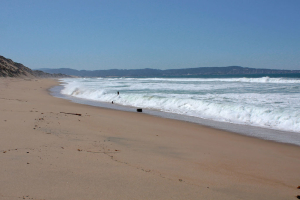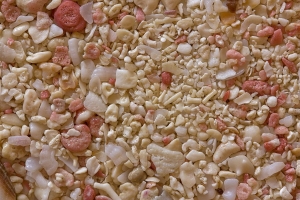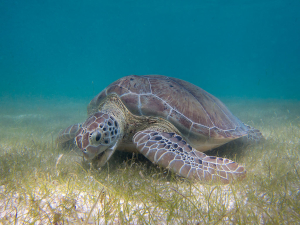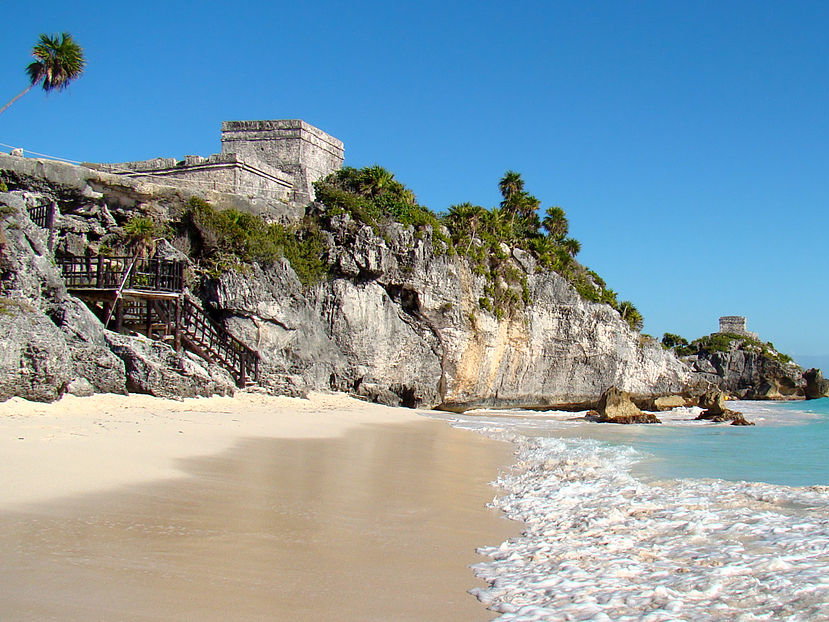Why they come, why they go, and what sargassum means to them
I’ve always thought it would be fun if we could radio-tag a grain of sand. You just never know where the thing has been, or what it’s made of, or where it’s headed from here. Pick up a few grains and put them in the palm of your hand. They might all have the same story, but it depends on the beach you’re standing on. Some beaches are quite homogeneous, and the grains are all from the same source. The gleaming black sands of the beaches of the Big Island in Hawaii are all from the lava that created that island. The whitest beaches in the world, on the Emerald Coast in Florida, are all from Appalachian granite. The beaches of our hometown of Monterey, California all come from the mouth of the Salinas River, and each grain has made that three-hundred-year, beach-to-dune-to-river-to-beach circuit several times. But here on the east coast of the Yucatan, we’re inside a barrier reef, and each of those grains of sand in your hand probably tells a different story. They might have been battered from some headlands, or washed from the mouth of an underground river, but more likely they have a biological origin. They might come from the gut of a fish who ate a fish who ate some coral. They could be shattered exoskeletons, or crushed shells, or the carapaces of tiny plankton or the spicules that make up the skeletons of sponges—or they could be the pulverized bones of an oceanic giant. They might have been body armor for an animal, but just as likely they protected a plant. And they all come together, all these grains, into great sweeps and berms and ridges, into crests and dunes, streaming, blowing, getting stranded and then swept away again, farther downwind or down-shore. They might blow inland and become marching systems of dunes, or wash outward and build shifting shallows and bars. In the end what emerges from all this constant motion is one of the most transient landforms in the geological world, the one we all love so much. Always in motion, always shape-shifting, always mesmerizing us and drawing us to it; often beautiful, always fascinating, and never, ever predictable. You gotta love a beach, but you’ll never walk on the same one twice.
Beaches have been on our minds here in the Caribbean lately, as they’re assaulted by unprecedented heaps of sargassum seaweed. Everyone wonders how to help them. In my last posting, sargassum turned out to be a fascinating organism. But what is a beach?

Monterey Bay, Northern California
Photo by Elery S. Oxford CC BY 2.0, via Wikimedia Commons
Susan and I come from Northern California, where the beaches are subjected to big forces. That coastline is exposed to that ocean, and that ocean is big, and the waves that hit it have been gathering momentum since the Gulf of Alaska. They effortlessly lift oil tankers out of their way as they pass under, and then continue building steam as they barrel southeast over a “fetch” of some fifteen hundred miles. What ends up hitting the headlands is explosive in its power, and thunderous in its tonnage. A good-sized one can be felt underfoot, and beaches on that coast can gain and lose a hundred horizontal feet between summer and winter. Susan and I have launched our ocean kayaks from charming pocket beaches nestled into bluffs, then returned a few months later to find a notch in the cliffs and a few cobblestones. And every beach is different. There’s a place south of Carmel called Monastery Beach where the face of the beach is so steep and so coarse that a kayak won’t stick to it. You have get in your kayak and get your paddle in your hands up on top of the crest, then shove off, ski down the berm, then launch through the surf. It’s a sporting proposition. And landing is even weirder.
A beach has body parts, but, as with any living thing, the body parts are always moving. There is a face that the waves run up, then a crest, which is overtopped only by the larger ones. There is a back beach which is largely flat, and that’s where the people lie around, or walk if they don’t want to dodge waves, and then behind that there will be another rise, sometimes called the storm beach, which is touched by waves only in the heaviest conditions. There the sand will dry out enough that wind becomes the shaping force instead of water, and grains are carried up and over small obstructions and drop into the dead air behind them, and embryonic dunes are created, and the dunes begin to grow and march inland. The underwater shallows and bars lead to the beach, which leads to the dunes, and all three act together to create a moving, shape-shifting rampart which protects the coast against heavy storms. As conditions change, the sand is exchanged freely between the elements of this triad. In stormy times, the beach is hit by rapid, back-to-back waves and the sand remains in suspension, getting no rest, until it is finally stripped away from the beach, creating bars and shallows just offshore, and those shallows cause the waves to break farther out, and blow their energy before hitting the coast. In really heavy conditions, like the storm surge that accompanies a hurricane, sand will get stripped even from the dunes, and carried back out to sea again. Then, when things are quieter, the beach is washed by smaller waves with longer periods between them, and the sand is carried back up and dropped and left, and the bars and shallows become beach again, and the beach heals and grows wider, and blows inland and replenishes the dunes. It’s a resilient system, and it is resilient because it’s responsive, constantly in motion. The reason it doesn’t break is because it bends. But it only works as long as it has a source of sand. Which brings us to longshore drift.
Longshore drift is what carries sand longwise up or down a coastline, and it is driven by the scalloping motion of waves angled slightly to the beach. This is what replenishes miles of beaches downshore from something like a river mouth. But sand is constantly leaving the system. It can hit a submarine canyon or a harbor mouth, or it can just get pulled out to sea beyond a depth called the depth of closure, where wave action no longer reaches it, and it is lost. If you have barriers at each end of a beach, say a headlands at one end and a canyon at the other, you are in a closed system called a littoral cell, and if your source of sand, whatever that is, does not keep up with the amount of it that leaves your cell daily, your beach is eroding, and you will lose it. It is called your sand budget, and every beach has one, and no beach gets to exceed it. Damming and pumping rivers can put a beach outside of its means. In our hometown of Monterey, California, the beaches are going away because the Salinas River is a ghost of its former self.

The demise of Tucker’s Island Lighthouse, Oct. 12, 1927
(Photo courtesy of NOAA)
All of this makes beach dynamics famously treacherous to tinker with. Many lives have been ruined when someone put a jetty or some other obstruction in the wrong place. In the very simplest scenario, everything downshore from the obstruction stops getting replenished by longshore drift and begins to erode, but it gets way more complicated than that. One time an entire island off the coast of New Jersey called Tucker’s Island just flat disappeared, and it was because they built a couple of jetties to try to save it. It was actually very sad—in the early nineteen hundreds it had a lighthouse, two hotels, guest cottages and a number of residences on it, all managed by a pioneering family of hardy souls, who some say had created the first beach resort in the U.S. But the island was eroding at its north end, so they built jetties across the inlet passage from it on the advice of an engineer from the University of Pennsylvania. It had the effect of reversing a critical current and making things worse, and longshore drift began stripping the island away in earnest. Three years later, the last structure to go was the lighthouse, and on October 12, 1927, it toppled into the sea. The lighthouse keeper photographed the whole thing on his Brownie box camera.
Here inside the Mesoamerican Barrier Reef, the source of our sand is almost entirely the reef. Some might come from outcrops or landslides, but for the most part creatures lived and died to give us this beautiful white sand. In fact, they probably lived and died and then passed through a whole chain of other creatures, so to a large extent you’re walking on fish poop, but don’t dwell on that. And that whole food pyramid is underpinned, as any food pyramid is, by those tireless primary producers, the photosynthesizers like the corals, the phytoplankton, the dune plants, the turtle grass, the coralline algaes—and the sargassum. It all gets broken down by micro-organisms and eaten by burrowing invertebrates, which is why we have shore birds working the surf zone and rays snuffling the sandy bottoms, noshing crustaceans and creating more sand. Some beaches require healthy rivers, and some require heavy surf pounding a headlands, but for us, it’s all about the reef. It is the reef ecosystem that creates our beaches. The reef is everything to us.
Sargassum is good for beaches in several ways, but sargassum does not become sand, at least not until you take an extremely long view of things. Sargassum has some mineral content, especially if it is encrusted by bryozoans, which most of it is (bryozoans can be pictured as tiny, filter-feeding creatures living in symmetrically-ranked glass condominiums—they’re another story), but that’s still not that much mineral content. Those piles of sargassum will not become same-sized piles of sand. But they will become organisms. They will fertilize plants and feed animals that become food for other animals, and as it all makes its way up the food chain, and the creatures have to protect themselves from herbivores and predators, they all start to employ a cute trick: They take calcium from the water around them, and the carbon that is the by-product of their own respiration, and they make calcium carbonate, CaCO3—it’s what every crab leg and coral frond is made of, and it’s what you are walking on when you stroll on the beautiful, powdered sugar beaches of somewhere like Tulum. In that sense, yes—sargassum becomes sand.
* * * *

The creatures who lived and died: This coral beach in Bermuda is coarse enough that you can make out the organisms who comprise it.
Photo by Siim Sepp CC BY-SA 3.0, via Wikimedia Commons
The first debate we’re all hearing these days is about whether to rake the beaches. Raking the stuff up and carting it away is nice for us beachgoers, but questions are being raised about whether it is good for the beach. Texas A&M University did the only study I could find on beach raking, and I was surprised by the results. They monitored the elevation of several beaches on Galveston Island with surveying equipment, half of them raked and groomed in front of hotels, and half untended in less developed areas. They found no difference in beach elevation after a year. They issue a few caveats, to be sure. They point out that they measured only elevation, not horizontal width or beach slope. And a year isn’t very long. They’re calling for more studies. But, according to this early data, raking seems not to be a crime. But it is the second part of their study that paints the picture more broadly, and takes in that triad of bars, beaches and dunes.
In that part of the study they examined the effect of sargassum on dune plants, and those results were conclusive—there’s no doubt about it, dune plants like sargassum, or at least the subject of their study does, which is a common dune grass called bitter panicum (Panicum amarum). And it likes it whether you wash it to remove the salt or not, whether you leave it on top of the sand or mix it in—sargassum is just great fertilizer. The panicum grows bigger, and puts out more roots and stabilizes the dunes better. Panicum actually prefers the stuff unwashed, and the scientists speculate that that’s probably due to other important nutrients staying in the mix—plants are typically limited by the availability of nitrogen, phosphorus and potassium. It’s important to remember, though, that panicum is a dune plant, and is salt tolerant. For use in your garden you’d probably want to wash the stuff.
The scientists do point out that sargassum is good for the beach as well as the dunes—it creates food and habitat and protects the sand from both wave and wind erosion—but in the end, they seem to recommend raking the beach, but then carting the stuff no farther than the base of the dunes and piling it there, and then, periodically (it doesn’t have to be daily) spreading it more broadly across the dunes for the benefit of the plants there.
People are asking me if sargassum can be eaten. The answer is yes, but the reviews aren’t exactly glowing. EatTheWeeds.com calls it “not a prime edible, but a plentiful one.” But they do go on to offer several ideas for preparing it.
It has been suggested that we sell the sargassum. Various species of brown algae are already harvested and used in numerous things, including bio fuels, food thickeners, pharmaceuticals, cosmetics, and extracts for medical uses. There’s a whole industry out there (a couple of industry websites are here and here), and in fact they used to harvest sargassum live from the Sargasso Sea, and the practice was opposed by conservation organizations like the Sargasso Alliance, and was finally regulated in most U.S. waters. But what if they could gather it from beaches? Well, it still poses environmental problems. It would mean heavy equipment on the beaches where the turtles nest, and generally it involves collecting the stuff in dump trucks, where the load can end up being eighty percent sand and water by weight. Then you drive it away to process it somewhere else, and all the salt and sand ends up in landfills, and, according to most reports, the beach takes a beating. But the University of Alicante in Spain has designed a system that is transportable. A truck backs it onto your beach on a giant trailer, and the sargassum is put through a three-stage process right there, finally creating cleaned and dried bales of the stuff, all without leaving your beach. As far as I can tell, this system has only been designed—one has not been built yet.

Green Sea Turtle (Chelonia mydas)
Photo by P.Lindgren CC BY-SA 3.0, via Wikimedia Commons
And, since they’re so close to everyone’s hearts around here including mine, I’ll close the article with a word about the turtles. I’m very sorry to report that sargassum does kill sea turtles. The Barbados Sea Turtle Project reports 42 dead, both greens (Chelonia mydas), which are endangered, and hawksbills (Eretmochelys imbricate), which are critically endangered. In 2014, the National Marine Fisheries Service reported 20 live and 23 dead green turtles stranded in the sargassum on U.S. beaches. The sargassum causes problems for them in several ways. First of all, when you swim among the turtles somewhere like the wonderful waters of Akumal Bay, they are so graceful and beautiful in the water that it’s easy to forget that they’re actually air breathers. They have to be able to get to the surface about every fifteen minutes, and a mat of sargassum pushed up against a coastline can get several feet thick, and if they cannot get up through it they will simply drown. Even if they reach the air, they might remain entangled, and end up beached and helpless in the mass of seaweed. It is also feared that nesting sea turtles will have trouble finding a clear patch of beach for a nesting site, and if their options are limited, they will get crowded together, and the result will be turtles digging up other turtles’ nests as they create their own. And then, of course, the hatchling has to get back through it all to reach the water, and that’s a trek which is already the most perilous sixty seconds of her life.
And that’s a life that might go on to span eight decades.
Now you know.
Sources:
http://treasureislandtx.org/TIMUD/Seaweed%20Report.pdf
–http://www.eattheweeds.com/sargassum-not-just-for-breakfast-any-more-2/
https://seaweedindustry.com/
http://news.algaeworld.org/
http://www.loopnewsbarbados.com/content/sea-turtles-victims-sargassum-seaweed
http://www.barbadosseaturtles.org/
http://www.sanpedrosun.com/environment/2015/08/08/sargassum-linked-to-dead-fish-washing-onshore/
https://sandiego.surfrider.org/wp-content/uploads/2010/01/DynamicsofBeachSand2007.pdf
http://www.houstonchronicle.com/neighborhood/bayarea/news/article/Groups-Seaweed-could-be-killing-sea-turtles-5585589.php
Tucker’s Island, By Gretchen F. Coyle and Deborah C. Whitcraft


Randy: Another great and extremely interesting works. It is always a pleasure for me to read you’r work. I always come away much informed. Please say hello to Susan. Thank’s Thomas
Thanks, Thomas! Good to hear from you!
Randy, Seriously your in depth analysis of all these subjects is just too non-amateurish.
Hari
Hari! My fellow curiosity junkie, it is so great to hear your voice! Thanks for the comment!
Wow!
Fantastic read, Randy! As with all your pieces, I just learned a ton of new fascinating things about Mother Earth. I’ve lived on beaches, sometimes wondered how much was known about their dynamics and workings, but never knew this stuff. Now I want to shout it from the mountain tops so that all might read and become enlightened.
Keep up the great work!
Thanks, By! Great to hear your voice!